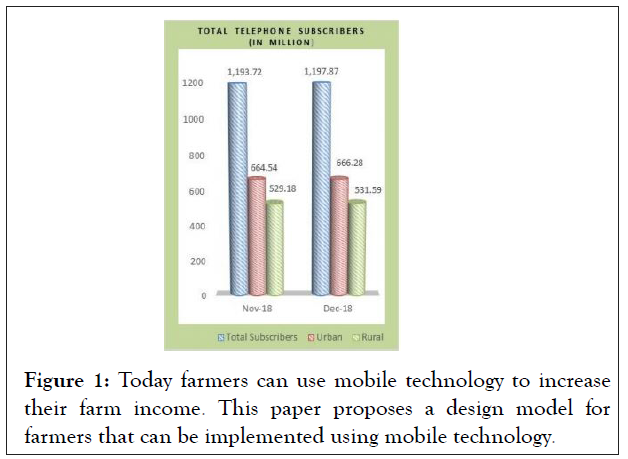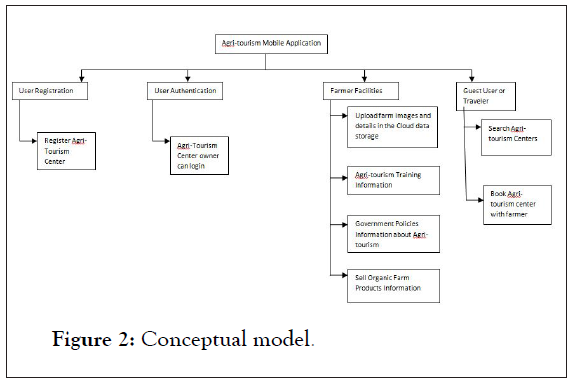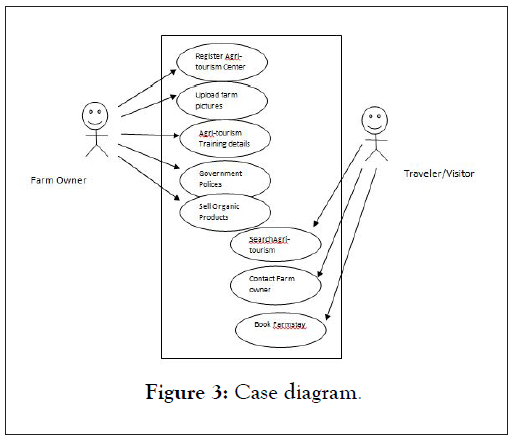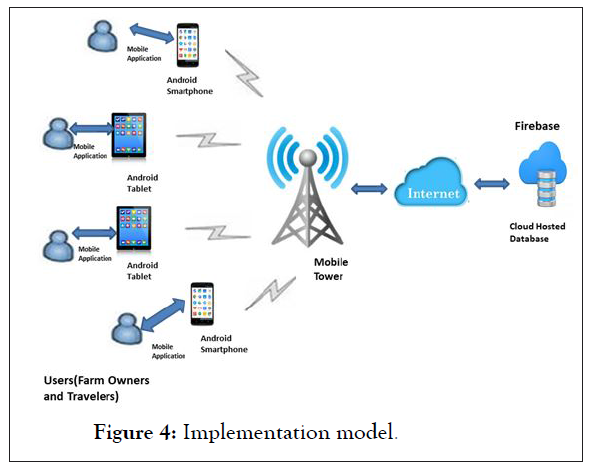Indexed In
- Euro Pub
- Google Scholar
Useful Links
Share This Page
Journal Flyer

Open Access Journals
- Agri and Aquaculture
- Biochemistry
- Bioinformatics & Systems Biology
- Business & Management
- Chemistry
- Clinical Sciences
- Engineering
- Food & Nutrition
- General Science
- Genetics & Molecular Biology
- Immunology & Microbiology
- Medical Sciences
- Neuroscience & Psychology
- Nursing & Health Care
- Pharmaceutical Sciences
Research Article - (2021) Volume 10, Issue 4
Proposed Model for Smart Agriculture Dissemination to Empower Indian Farmers
Ranjita Rathore*Received: 09-Jun-2021 Published: 30-Jun-2021, DOI: 10.35248/2319-5584.21.10.114
Abstract
The world has become the small village in 21st century due to the advancement of ICT technology. The most populars ICT tool is Smartphone and is playing a strategic role in the development of modern farmer. This most popular ICT tool is driving global agriculture. The recent advancement in ICT bring forth great opportunities to ride over the costly and redundant technologies that the poor farmer could not have afforded. This technology is cheap, farmer friendly and very useful. Farmers are using mobile apps very rapidly in their daily tasks. This paper is presenting a model for designing and implementing smart agriculture dissemination. The model concentrates specifically on Agri-tourism and shows how farmers and consumers in this sector can share mobile platform to fulfill their various needs.
Keywords
Mobile apps; Modern ICT; Smartphone; Agri-tourism; Smart agriculture
Introduction
Agriculture is the one of the oldest and crucial occupation since the history of humankind is maintained, as there is direct dependency between man and agriculture. This sector and its allied sectors are primary source of income to the majority of population in India and across the world. This sector plays a very important role in social and economic development of any country in the world. In India also more than half of the country's population directly depends on the farming for their livelihood. This sector not only provides food security to the country's ever growing population but also provide raw materials to the industries, influences internal and external trade, commerce and national income. Despite of this rosy picture of agriculture, farming sector is facing several challenges all over the world. India is one of the biggest producers of agro products but still farm productivity in India is very low and most of the farmers are in debt. Farming sector is the main occupation for livelihood in rural region, yet this sector carries the blot of farmer's suicides, poor crop yields, low crop quality, climate threat and many more serious issues. Most of the farmers are below poverty line because of the above serious issues. Due to this farmers don’t want their future generations to involve in farming. This is creating agro brain drain, farmers and their children are migrating towards urban areas, and this is reducing food producers and increasing food consumers day by day.
Undoubtedly rural development in India is increasingly associated with agriculture, which is considered as a central force of economic growth and development in rural areas. To retain our food producers in the rural area, new technology, new ways of additional income, modern agricultural concepts must be introduced to the farmers. Farmers need to learn the supplementary income generation methods to raise their farm income. There are several methods linked to agriculture that can raise farmer’s income such as fishing, dairy, poultry, rural tourism etc. One of the emerging concepts of increasing farm income is Agri-tourism [1-2].
The travel and tourism industry plays a vital role in any country's GDP. In the past few years the trends in tourism industry is changing rapidly. Today with the high pressure lifestyle, highly disposable incomes and development of faster and cheaper modes of travel more and more people travel spontaneously. At present travelers look for newer holiday destinations, want to learn new things, connect to nature, see different cultures and not limit their search to mainstream and popular destinations only. Due to these new concepts like Agri-tourism or farm tourism, wine tourism, ecotourism, rural tourism etc have evolved. Agri-tourism is one of the popular businesses growing at fast rate. Due to fast paced, loud and busy urban lifestyle more and more people want to visit places where they can rejuvenate their mind [3]. Body and soul and get mental peace, healthy there traditional food, fresh air and many more. Real India lives in villages and agriculture is one of the main occupation for the rural people. It is the need of the hour that farmers should look for allied income sources related to farming that can raise their socio economic status. Agri-tourism is one such good option that farmers can use to increase their farm income. With the advent of new technologies like ICT, world has become the small global village. Smartphone is the new ICT tool that has brought a new revolution. Mobile apps or mobile applications to and services are the new user friendly ways of fulfilling our daily needs of information and communication. Smartphone is so popular that even illiterate person can use is easily. In India also the number of mobile subscribers increased from 1,193.72 million at the end of Nov-18 to 1,197.87 million at the end of Dec-18. The urban subscription increased from 664.54 million to 666.28 million at the end of year 2018, and rural subscriptions increased from 529.18 million to 531.59 million during the same period. So the monthly growth rates of rural and urban subscription were 0.46% and 0.26% respectively in the end of the year 2018 (Figure 1).

Figure 1: Today farmers can use mobile technology to increase their farm income. This paper proposes a design model for farmers that can be implemented using mobile technology.
Methods and Materials
To design a model for farmers we have collected primary data through questionnaire and field interviews on mobile applications usage among farmers and urban people across Pune region in India. Questionnaires contain several close and open ended questions. They were given to urban people and ATC owners (Agri-Tourism Centre owners). Around 120 urban people from different regions in India have participated in the study and 80 ATC owners from Pune region have participated [6].
Research observation
Among the urban people respondents 92% people like newer holiday destinations like Agri-tourism over mainstream destinations, and 96% feels that it is very good concept for supplementary income generation for farmers but lacks marketing. Most of the people visit ATC centers by mouth publicity and they feel that there is a need of digital marketing of such emerging concepts that can help the farmers to boost their farm income. Also urban respondents feel that a online marketing platform is needed for Agri-tourism common for both ATC owners and consumers so that farmers can directly communicate to the travelers and increase their profit [4].
ATC owners feels that urban respondents use websites, mobile applications and mouth publicity most to visit their farms. 87% of ATC owners feel that urban respondents use mobile applications more to book their tour online. 62% of the ATC owners feels the main barriers that they are not able to attract travelers is lack of marketing and less awareness about Agritourism business [5].
Proposed mobile framework
In this section we will discuss about the proposed mobile framework. Here, the conceptual model, the system components and implementation model are presented.
Results and Discussion
Conceptual model
This section discusses the conceptual model of the system. This is the top level overview of the components of the system. In this model the components and entities are shown. The user was registration, user authentication, farmer facilities, Guest user and user/traveler are the top level components. The user registrations databased on is the component which first registers the farmer to the cloud hosted database (Firebase). There are two types of users, the farm owner and the traveler who visits the farm. The system GUI will display according to the access level of the user. The user authentication is the component which authenticates the registered user before accessing the system [7].The farmer has facilities is the component which loaded to give GUI for uploading farm pictures, Agri-tourism related information, selling organic products and government policies. The Guest user is the component for searching and booking the Agritourism centers (Figure 2).

Figure 2: Conceptual model.
System components
The components of the system were developed based on the CBD concept of software development. There are two types of users that can access the system, farmer and guest user. Both the user has the designated function and can access the system according to the level of access grant they are allowed. The farm owner has the full access of the system . He can register his farm, upload farm pictures to the database, can look for other information as well. The guest user can search, contact farmings owner and book farm stay. Figure 3 below is the use case of there system which depicts the system components (Figure 3).

Figure 3: Case diagram.
System implementation
This mobile application is an android based application developed using android software development platform and works on any android device . The application can be hosted on small and portable device such as smart phone and tablet. The server side HTTP connects and GPRS, 3G or 4G enabled mobile internet access. The development languages used will be java and real-time cloud data source is used as database. All the farmer's data will be stored on cloud and can be fetched anytime anywhere. Implementation model is described as below (Figure 4).

Figure 4: Implementation model.
Conclusion
With the high penetration of mobile technology in rural areas, this technology can be applied in agriculture to ease agribusiness and improve agricultural productivity. Mobile applications are farmer friendly, cheap, easily accessible and very good medium of information dissemination. The proposed mobile agriculture model is workable solution towards the design and implementation of mobile application in Agri-tourism business. This designed model can be used by software developers to create mobile applications that are focused on Agri-tourism business and to implement various processes involved in that business.
REFERENCES
- Gichamba A, Lukandu A. "A model for designing M-Agriculture applications for dairy farming". Afr J Inf Syst. 2012;4(4).
- Adhikari T, Kundu S, Biswas AK, Tarafdar JC, Subba Rao A. Characterization of zinc oxide nano particles and their effect on growth of maize (Zea mays L.) plant. J Plant Nutr. 2015;38(10):1505– 1515.
- Agrawal S, Rathore P. Nanotechnology pros and cons to agriculture: A review. Int J Curr Microbiol App Sci. 2014;3:43–55.
- Bramhanwade K, Shende S, Bonde S, Gade A, Rai M. Fungicidal activity of Cu nanoparticles against fusarium causing crop diseases. Environ Chem Lett. 2015;14(2):229–235.
- Ghafariyan MH, Malakouti MJ, Dadpour MR, Stroeve P, Mahmoudi M. Effects of magnetite nanoparticles on soybean chlorophyll. Environ Sci Technol. 2013;47:10645–10652.
- Guo LJ. Recent progress in nanoimprint technology and its applications. J Phys D Appl Phys. 2004;37(11):R123.
- He L, Liu Y, Mustapha A, Lin M. Antifungal activity of zinc oxide nanoparticles against botrytis cinerea and penicillium expansum. Microbiol Res. 2011;166:207–215.
- Hussein MZ, Yahaya AH, Zainal Z, Kian LH. Nanocompositebased controlled release formulation of an herbicide 2, 4- dichlorophenoxyacetate incapsulated in zinc-aluminium-layered double hydroxide. Sci Technol Adv Mater. 2005;6(8):956–962.
- Mattos BD, Magalhaes WL. Biogenic nanosilica blended by nanofibrillated cellulose as support for slow-release of tebuconazole. J Nanoparticle Res. (2016);18(9):274.
Citation: Rathore R, Mandot M. (2021) Proposed Model for Smart Agriculture Dissemination to empower Indian Farmers. Glob J Biol Agric Health Sci. 10:114.
Copyright: © 2021 Rathor e R, et al. This is an open-access ar ticle dis tribut ed under the t erms of the Cr eativ e Commons A ttribution License, which permits unrestricted use, distribution, and reproduction in any medium, provided the original author and source are credited.

